
Weeding & Water & Bugs, Oh My!
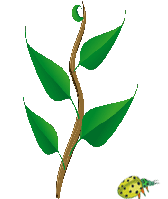
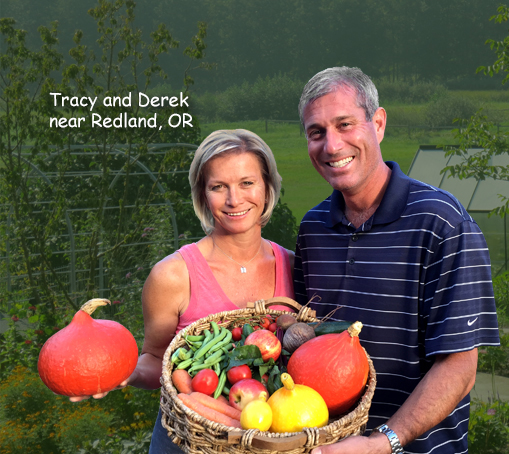
We get it. Gardening in the Northwest can be a challenge: wet springs that last into June, hot summers without any rain, new bugs and diseases every few years. A little help at the right time can make all the difference in your busy life! We love gardening and hope to share that passion with you. Just check us out 🙂
- Monthly planting calendar
- New & unusual plant reviews
- Money saving tips
- Garden problem solvers
- Preserving ideas and recipes
- The right info, just when you need it
Spring in the Northwest Garden
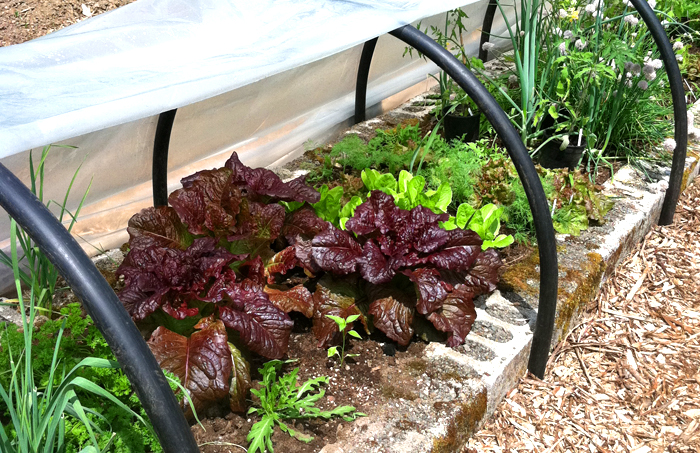
A cold frame is like a miniature greenhouse, built low to the ground and mainly used to protect plants during the cooler months. Without a cold frame in your garden, winters in the Pacific Northwest are too cold and wet to grow many veggies. But add just a little protection and watch the magic! You can grow an abundance of fresh, healthful veggies with little cost and not much work – Easy Peasy!
![]() A covered garden lengthens the growing season (the time between frosts). Veggies start growing earlier in the Spring and grow happily later into the fall. It’s like moving your garden 600 miles to the south – but without the crowds.
A covered garden lengthens the growing season (the time between frosts). Veggies start growing earlier in the Spring and grow happily later into the fall. It’s like moving your garden 600 miles to the south – but without the crowds.
![]() It’s cheap. Cold frames or cloches can be built from salvaged materials like old windows or sliding glass doors but even newly purchased supplies are inexpensive.
It’s cheap. Cold frames or cloches can be built from salvaged materials like old windows or sliding glass doors but even newly purchased supplies are inexpensive.
![]() We all want a little warmth and tenderness, veggies included. A cold frame, cloche or greenhouse captures heat from the sun and earth and holds it near your plants, speeding germination and growth. A cold frame in April is like the Jurassic jungle – a verdant, seething mass of explosive growth ready to take over the world.
We all want a little warmth and tenderness, veggies included. A cold frame, cloche or greenhouse captures heat from the sun and earth and holds it near your plants, speeding germination and growth. A cold frame in April is like the Jurassic jungle – a verdant, seething mass of explosive growth ready to take over the world.
![]() You can harvest during the winter and early spring when store-bought produce is most expensive. Instead of $3 a head for lettuce that’s been beat to pieces for a thousand miles you can have fresh, beautiful produce from your own garden. No trucked in, south-of-the-border lettuce for me Baby! How local is that?
You can harvest during the winter and early spring when store-bought produce is most expensive. Instead of $3 a head for lettuce that’s been beat to pieces for a thousand miles you can have fresh, beautiful produce from your own garden. No trucked in, south-of-the-border lettuce for me Baby! How local is that?
![]() The more veggies the better. Listen, you can’t grow pumpkin pie or Mounds bars in the garden. Having veggies just waiting for you out the back door is bound to encourage healthy eating. Halloween, Thanksgiving, Christmas, New Year’s… need we say more?
The more veggies the better. Listen, you can’t grow pumpkin pie or Mounds bars in the garden. Having veggies just waiting for you out the back door is bound to encourage healthy eating. Halloween, Thanksgiving, Christmas, New Year’s… need we say more?
![]() No mud, thanks. Endless rains compact the soil surface and leach away vital minerals. Some people spread tarps over their garden beds in the winter for this very reason – why not make that covering clear and grow some delicious, healthful veggies underneath?
No mud, thanks. Endless rains compact the soil surface and leach away vital minerals. Some people spread tarps over their garden beds in the winter for this very reason – why not make that covering clear and grow some delicious, healthful veggies underneath?
![]() Less watering. Those blistering hot August days can mean watering every day or two but a cold frame recycles its own water. As water vapor inside contacts the cold covering it condenses and falls back down as a gentle rain. During humid, rainy periods you may not need to water for weeks at a time.
Less watering. Those blistering hot August days can mean watering every day or two but a cold frame recycles its own water. As water vapor inside contacts the cold covering it condenses and falls back down as a gentle rain. During humid, rainy periods you may not need to water for weeks at a time.
![]() Don’t bug me! Insect pests are at their height in the summer garden but are rarely seen in the winter cold frame or cloche.
Don’t bug me! Insect pests are at their height in the summer garden but are rarely seen in the winter cold frame or cloche.
![]() A home for your tender or tropical plants. We love tropical potted plants during the summer but most won’t survive the winter unprotected. If well insulated on the coldest nights (like below 30 degrees) many tropical plants like begonia, ginger or hibiscus can survive Northwest winters quite happily in a cold frame.
A home for your tender or tropical plants. We love tropical potted plants during the summer but most won’t survive the winter unprotected. If well insulated on the coldest nights (like below 30 degrees) many tropical plants like begonia, ginger or hibiscus can survive Northwest winters quite happily in a cold frame.
![]() Wind, rain, hail, more rain – this does not make your plants happy. Wet conditions encourage diseases that can rot plants down to a sad brown lump. Cold, dry winds can suck the moisture from vulnerable leaves or simply knock plants over.
Wind, rain, hail, more rain – this does not make your plants happy. Wet conditions encourage diseases that can rot plants down to a sad brown lump. Cold, dry winds can suck the moisture from vulnerable leaves or simply knock plants over.
![]() Toughen up, Cupcake. Plants you’ve started indoors need to be “hardened off” before transferring to the garden. A cold frame provides the perfect transition from cushy indoor conditions to life in the wilds of your garden.
Toughen up, Cupcake. Plants you’ve started indoors need to be “hardened off” before transferring to the garden. A cold frame provides the perfect transition from cushy indoor conditions to life in the wilds of your garden.
![]() Your covered bed is ready to plant earlier in the year. While Neighbor Bob is waiting for his cold, soggy garden to dry out you can happily plant (and harvest!) months earlier. A cold frame is also a great place to start flats of veggies for later planting in the garden.
Your covered bed is ready to plant earlier in the year. While Neighbor Bob is waiting for his cold, soggy garden to dry out you can happily plant (and harvest!) months earlier. A cold frame is also a great place to start flats of veggies for later planting in the garden.
![]() Without a covered bed you’re missing out on some of the best growing conditions of the year. Check out the chart below – from March to June the days get longer and daytime temperature warms but nights are still cold and the soil in your garden is too wet to work. A cold frame allows you to take advantage of this time to grow abundant, beautiful veggies with less work, little cost and under ideal conditions.
Without a covered bed you’re missing out on some of the best growing conditions of the year. Check out the chart below – from March to June the days get longer and daytime temperature warms but nights are still cold and the soil in your garden is too wet to work. A cold frame allows you to take advantage of this time to grow abundant, beautiful veggies with less work, little cost and under ideal conditions.
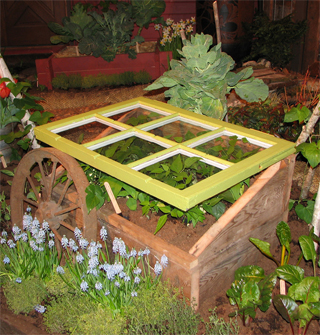
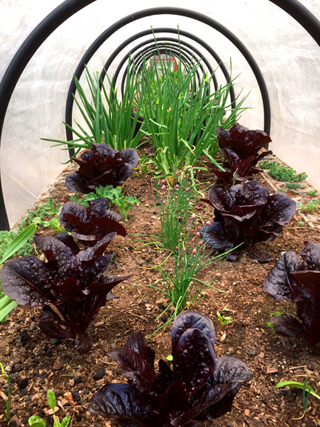
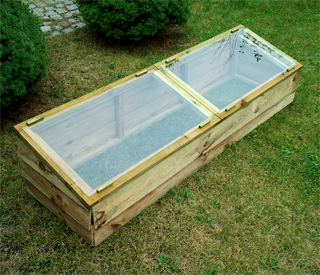
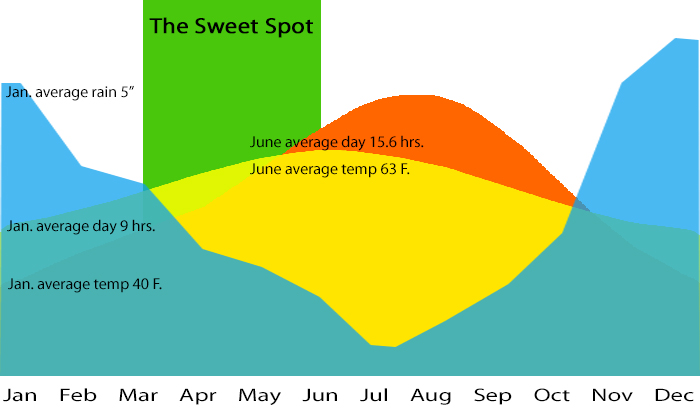
Early spring is a great time to grow veggies in a cold frame.
Leafy greens are especially good: Lettuce, Swiss chard, arugula, spinach, corn salad, parsley, mustard greens and cilantro are great. For variety add radishes including daikon, Bok Choy, kale, cabbage and onions.
The Top 5 Organic Ingredients for the Most Beautiful Garden Ever!
Minerals—Lime and Azomite
Here in the Pacific Northwest heavy winter rains wash calcium and other minerals from the soil year after year. To grow the most abundant, beautiful garden, with the most nutritious produce, we need to replace these minerals. Many gardeners in this area routinely add lime to the soil—this is an excellent practice since our wet soils also tend to be acidic. We recommend 50 lb. per 1000 sq. ft of agricultural lime annually and the same rate for Dolomite (which also contains magnesium) substituted for Ag lime every 2-3 years. Almost all common fruits and veggies will grow and taste better with an application of lime.
Azomite is the trade name of a mineral product mined from an ancient deposit in Utah that contains a broad spectrum of 70 minerals and trace elements. Azomite has been reported to improve root systems, yields and general plant vigor in a variety of field crops and garden vegetables. Gaia Green Glacial Rock Dust, a similar product, and Azomite are both certified for organic production. We have had great results with both products and, in fact, prefer using 50% of each to help ensure a balanced spectrum of minerals.
The last time we checked (Feb. 2017) a bag of Azomite was $48 with free shipping here on Amazon. Azomite can also be purchased locally in Portland, Seattle or Vancouver BC at these locations.
1 pound per 10 square feet ought to be a good starting point.
Best Uses:
- Any soil that gets more than 25” of rain a year. Sound familiar?
- Health-conscious gardeners interested in producing the most nutritious, mineral-rich produce.
Fish emulsion
“Fish Oil”, as old timers call it, has long been a favorite of organic gardeners. Fish emulsion is usually 5-1-1 NPK so it’s main benefit is to provide a shot of nitrogen. In the Pacific Northwest this is especially important in the Spring when cold soil temperatures mean there isn’t much nitrogen available naturally. Like all things from the sea (think seaweed) it also provides a healthy dose of trace minerals.
Best Uses:
- Apply about one week after putting transplants in the ground. Newly transplanted seedlings are inevitably in shock for a week or so and aren’t ready to take up much in the way of nutrients.
- Apply every 2-3 weeks during cool weather, once a month or less after that.
- Fish emulsion is the perfect “pick-me-up” for any plants showing signs of stress like yellow leaves, stunted growth or even insect attack.
Compost
Adding organic matter is the best thing you can do for the long-term health of the soil and plants in your garden. Compost adds nutrients and beneficial bacteria to the soil and improves the ability of the soil to hold moisture. Compost also improves soil structure, meaning the soil stays lighter, contains more oxygen for plant roots and is easier for tiny rootlets to penetrate. An improved soil can be worked earlier in the spring and with greater ease.
Producing compost can be as simple or as complex as you prefer. Just pile together any handy organic matter, like leaves, food waste, manure or grass clippings and let it rot. Ideally, a mixture of “browns” like leaves and “greens” like grass clippings will produce the best quality compost. Toss in an occasional bucket of soil to capture more of the available nitrogen. We prefer a closed bin for kitchen food waste and a big pile for leaves and grass clippings. Whatever method works for you, the important thing is to add some kind of organic matter to your garden soil.
Commercial compost can be valuable but be careful of municipal “Yard Debris Compost”. These products are sometimes contaminated with persistent herbicides, oil from leaves collected off city streets, pesticides and heavy metals. Try a high quality compost from a commercial dairy for veggie beds and save the lower cost YDC for landscaping or building a new bed for berries or vines.
Compost Tea
Liquid organic fertilizers can be quite expensive if you have a garden of any size so why not make your own? Compost teas are quicker acting than solid fertilizers and are best used when soils are cold or anytime your plants need a quick boost.
Manure, grass clippings, comfrey or chopped weeds also make excellent “tea”. Just fill a bucket 1/4 full of manure or 2/3 full of anything else and let it steep for three days at room temperature. Let it go much longer and the mixture will begin to ferment. Believe us—a bucket of two week old comfrey tea produces a mighty powerful stink! Stir once a day then dilute the extract 1:1 with water.
Pee
Yes, we said pee! Pee, pee, pee! Human urine is nitrogen-rich, readily available and it’s free, free, free!
Urine is virtually sterile when produced and in fact carries far less bacteria than manure which has been used in farming for centuries. Why use chemically treated water to flush this limited resource away? Try capturing in a jug, on a straw bale, in bucket of sawdust or on the compost pile.
All fertilizers contain salts that can build up in the soil and eventually harm plants or burn plant leaves. Urine is especially high in sodium and must be diluted 1:20 with water or about 3/4 cup urine to one gallon of water for seedlings and transplants. For larger established plants use up to a 1:10 ratio. Urine diluted with water is about 3-1-2 NPK. Mix with potassium-rich compost or grass clipping tea and you’ll have a nicely balanced product without spending a dime.
